Swimming freely next to sharks is completely different than cage diving. Though you aren’t going to be seeing great white sharks you will see plenty of other species including hammerheads, tiger, silky, reef, and whale sharks.
Shark diving is a thrilling adventure that is guaranteed to get your blood flowing. It’s certainly only reserved for the bravest and adventurous divers. In order of greatness, here are the top 16 list of best places to scuba dive with sharks.
Rules for swimming with sharks:
- Don’t make sudden or rapid movements
- Try not to turn your back to a shark
- Never corner or threaten a shark
- Stay close to the seafloor
- Avoid carrying any silvery or shiny objects
- Relax, enjoy, and take photos
18.) Hebrides Sea, Scotland
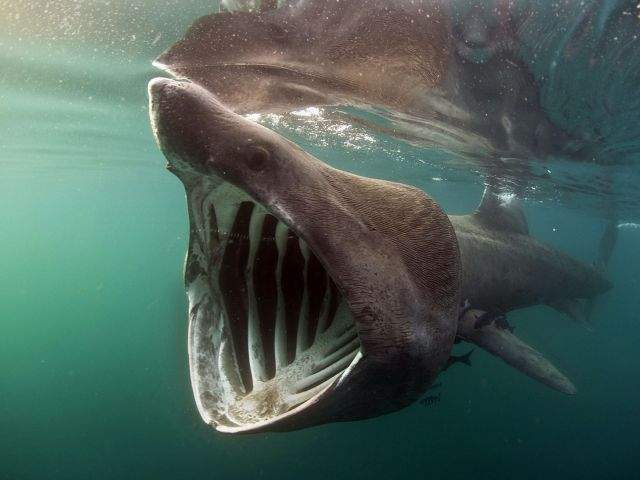
Species: Basking
Best Time to Go: June-September
Basking sharks migrate to Scotland to feast on plankton blooms. Scotland actually has the highest number of migrating basking sharks in all of the northern hemisphere.
The basking shark is the second-largest shark with whale sharks being the largest. These filter feeders can grow up to 39 feet (12 m) long and weigh up to 11,000 pounds (4,989 kg).
They are gentle, docile and are more worried about eating plankton than the spectators nearby. They behave just like whale sharks in that matter.
Diving with basking sharks is one of those rare diving experiences that are found in almost no other place in the world.
The main attraction is defiantly the basking sharks however, seals and dolphins are also common in the region. Puffins can be seen April-August and seals are seen year-round. Minke whales cruise on through from July to August.
Expect colds waters since the temperature only ranges from 43-64 F (6-18 C). Visibility drastically varies from 6-98 feet (2-30 m) depending on the time of year.
It’s a 3 hour boat ride to the dive site and snorkeling or solely spectating from the boat are also options.
17.) Beqa Lagoon, Fiji

Species: Tiger, bull, lemon, reef, silvertip, nurse
Best Time to Go: July-September
Beqa Lagoon is located south of the town Viti Levu on the main island. It’s 100 square miles (259 sq. km) of clear water surrounded by 19 miles (30 km) of barrier reef.
There are at least 6 prominent shark species that frequent the lagoon including bull, lemon, reef, and nurse. The sharks range in size from 7-10 feet (2-3 m) long.
The waters are sometimes chummed but it depends which operator you go out with.
The water temperature is almost always at 79 F (26 C) and visibility is 33-98 feet (10-30 m). Though diving is great year-round the best visibility is from July through September.
Depth in the lagoon is 16-98 feet (5-30 m) and is perfect for all experience levels including beginners.
There are 30+ dive sites in the area with things to see like fringing reef, shipwrecks, coral outcroppings, pinnacles, and colorful soft coral.
Some other marine life to expect is tuna, barracuda, rays, turtles, and sometimes blue marlin.
16.) Socorro Islands, Mexico
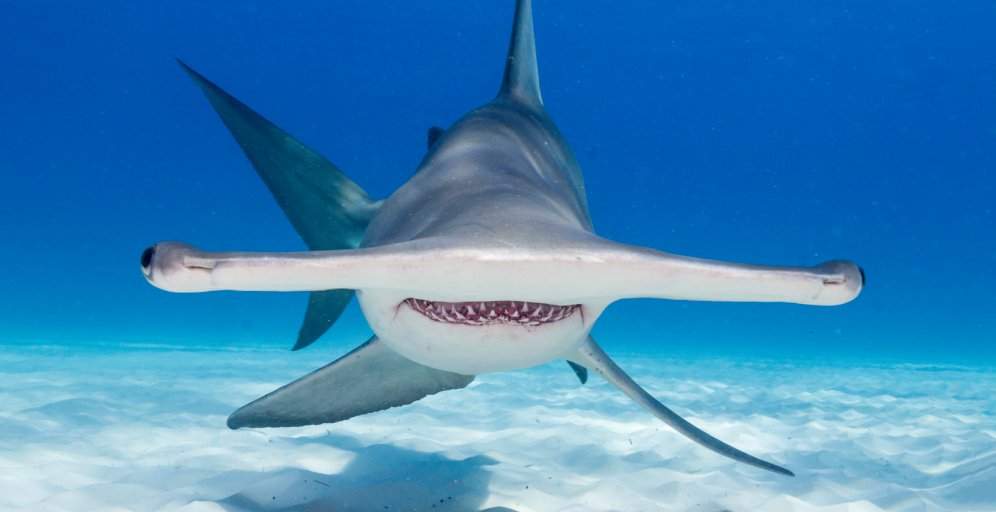
Species: Galapagos, tiger, hammerhead, whale (November-December), silky, oceanic whitetip
Best Time to Go: November-May
Socorro Island is an isolated location in Mexico with fantastic diving. It’s located 240 miles (386 km) off the Baja Peninsula and highly sought after by skilled divers.
It’s a bit of a journey to reach the island however, it’s more than worth it. During December through March thousands of humpback whales breed give birth in the area. Along with humpback whales, the islands are known for high populations of dolphins, manta rays, barracuda, and tuna.
In addition to all these wonderful species of marine life, the islands are famous for their shark populations. There are many species of sharks including hammerhead, tiger, and whale that are commonly seen by divers.
Hammerhead sharks are most commonly seen around the dive site Roca O’Neil aka Hammerhead Central. Several other species of sharks zip on past in the current including Galapagos, silky, and tiger.
Water temperatures vary from 70-82 F (21-28 C) and visibility is
Socorro island is only reachable by liveaboard which normally last 7 days. The boat ride to the island takes 24 hours.
The currents are strong and unpredictable so beginners are not advised to attempt to dive this location.
15.) Osprey Reef, Australia
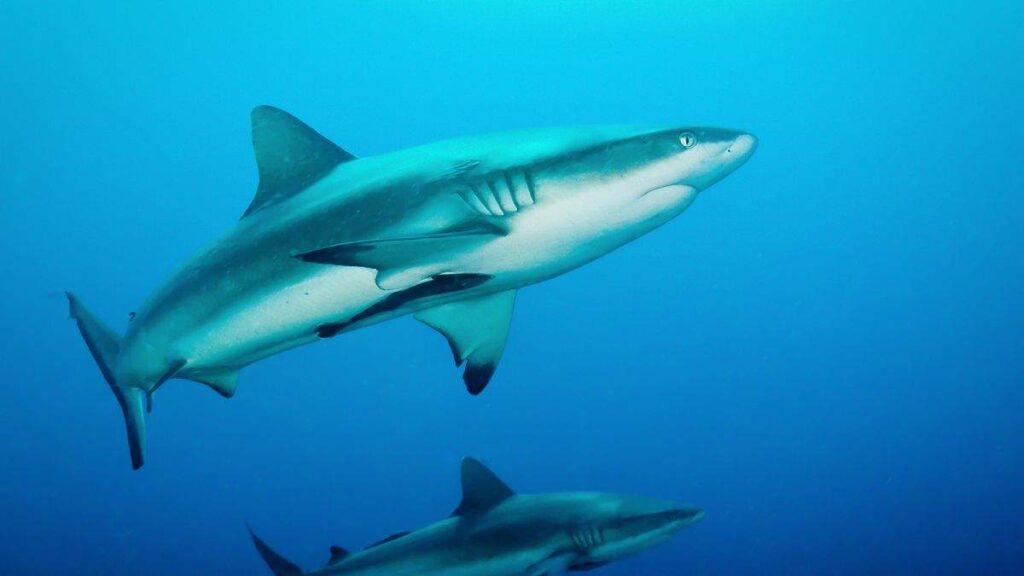
Species: Reef, silvertip, whitetip, silky, tiger
Best Time to Go:
Osprey Reef is the most northern section of reef in the Coral Sea. It’s located 217 miles (350 km) from Cairns. It’s full of some of the most amazing marine life a diver will ever see.
Soft coral grows to an astonishing 82-131 feet (25-40 m) and a massive coral wall that drops over 1,312 feet (400 m) at Osprey Reef. Not to mention the massive fish population. It’s some of the best in the world. No exaggeration. Ever since I did some scuba diving in the area I have yet to find another site that can compare.
North Horn is one of the most famous dive sites in Australia, especially for shark diving. Visibility is amazing and almost always at 131 feet (40 m).
Bait is used to attract sharks which is very common here. Grey sharks are food aggressive however generally speaking they have no real interest in attacking divers. Their mouths are just too small for them to even attempt it.
Australia: 10 Dive Sites Worthy of Your Bucket List
Grey, whitetip, and silvertip sharks are the most prominent type of species found at North Horn. You will see tons of them as they aggressively charge toward the bait fighting to be the first one to eat. Hammerheads are also occasionally spotted around North Horn.
Water temperatures are 72-84 F (22-29 C) and visibility is 33-131 feet (10-40 m). Visibility is great year-round but September though November is the very best.
If you happen to be in the area from June through November, humpback whales migrate through. You can see and hear them as the communicate to each other under the water.
Since the Osprey reef is far out to sea the only way to reach it is by a liveaboard trip.
14.) Cocos Island, Coast Rica

Species: Galapagos, reef, silky (December-May), tiger, silvertip, whitetip, guitar, hammerhead (June-November)
Best Time to Go: May-August
Cocos Island in Costa Rica is probably most famous for its big schools of hammerhead sharks. The hammerheads are most abundant from June through November and even though this is the rainy season, it’s well worth the trip.
Most sharks including hammerheads get themselves “cleaned” by smaller fish. It’s a mutual relationship where the fish eat bacteria from the sharks bodies, gills and mouths and in return the fish get a full meal.
King angel fish and butterfly fish are just two of the many species of fish that act as cleaners to hammerhead sharks. These cleaners are abundantly found in the waters surrounding Cocos Island.
Hammerheads do spook easily so if a diver starts moving erratically they will swim off quite quickly.
Whitetip sharks are a common sight and you will see dozens of them at a time on just about any dive around the island.
Water temperatures vary depending on the season but range from 73-82 F (23-28 C). Visibility ranges from 40-70 feet (12-21 m).
The only way to reach Cocos Island is by liveaboard and there are several options depending on how long you prefer to go out for. The average is 10 days though.
13.) Marsa Alam, Egypt

Species: Oceanic whitetip (October-December), hammerhead (May-August), thresher (October-January), silvertip, reef, whale (May-June), guitar
Best Time to Go: May-August or October-December
Marsa Alam, Egypt has been growing as a popular dive site since 2002. It’s less crowded with better reef systems then sites just a bit north like Hurghada or Sharm El Sheikh.
Oceanic whitetip sharks are the main attraction at Marsa Alum Egypt. It’s one of the best places in the world to see them. The best site for these sharks is at Elphinstone reef. You can dive with oceanic whitetip sharks from October through December.
Schools of hammerhead sharks are also seen at Elphinstone reef from May through August.
Whale sharks pass through from May to June and are a spectacular sight to see. The visibility is on the lower side (70 feet/ 21 m) due to plankton blooms. Whale sharks love to eat plankton so the blooms are what draws them into the area.
Abu Dabbab is a dive site that frequently has guitar shark sightings. It’s also where you can have an up-close encounter with the endangered dugong.
Abu Dabbab is one of the very few dive spots in the world where you can swim with dugongs.
This medium-sized marine animal is the cousin of the manatee and is endangered. The loss of habitat, erosion, and pollution has seriously impacted dugongs and drastically reduced their population.
There are regularly strong currents so it’s not the most ideal place for true beginners. Water temperatures range from 75-86 F (24-30 C) and visibility is 66-197 feet (20-60 m).
12.) Nassau, Bahamas
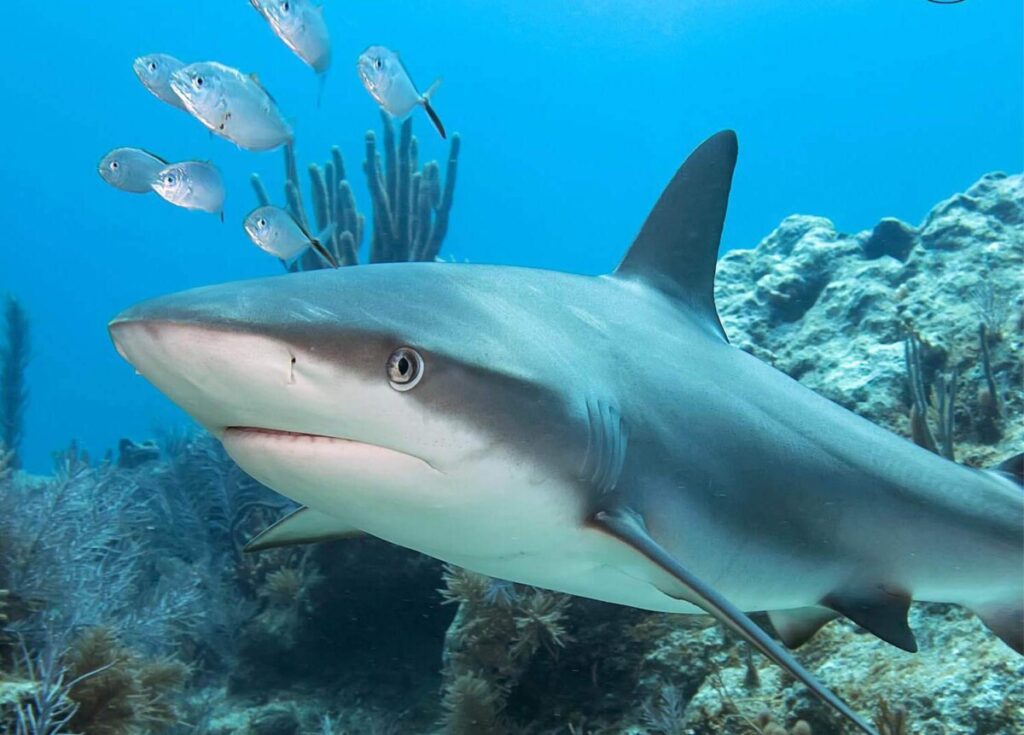
Species: Caribbean reef
Best Time to Go: Year-round
The Bahamas is a divers paradise and a shark haven. It’s no wonder the Bahamas made it on our list twice. Keep reading to find out how Tiger Beach, Bahamas ranked on the list.
Caribbean reef sharks are very prominent in the Bahamas and especially on Near Nassau, New Providence Island. These sharks prefer to be near reefs in tropical waters and the Bahamas checks all those boxes.
These sharks can grow 6-10 feet (2-3 m) and weigh up to 150 pounds (68 kg). They are not an aggressive species and not considered dangerous to divers. This is why you can swim with them without worrying about an attack.
The best dive sites to swim with Caribbean reef sharks is Shark Wall, The Arena, The Runway, and Shark Wall North. No matter which site you visit there will be lots of reef sharks. It’s guaranteed.
Fast Facts: Caribbean reef sharks are the first ones to arrive at feeding sites. This includes when waters are chummed.
The depth of sharks dives is usually 40-60 feet (12-18 m) and visibility is a consistent 80-100 feet (24-30 m).
All skill levels of divers can participate even true beginners since the waters are calm and the dive is most just about watching and taking photos.
11.) Jupiter, Florida, USA

Species: Lemon, tiger (November-March), hammerhead, bull, dusky, silky, sandbar, blacktip, reef, spinner, mako
Best Time to Go: Year-round/ June-September
Don’t underestimate the shark diving in Florida, USA. They actually have the highest concentration of sharks in the entire east coat. It’s about a 1-hour boat ride from the shore to deep waters where the sharks like to hang out.
Bull, sandbar, silky, and lemon sharks can be seen year-round. Tiger sharks appear during the winter months around November through March. Scalloped and smooth hammerheads are spotted during the summer months (June-September) and great hammerheads are seen in the winter (December-February).
Most operators will chum the waters to lure in the sharks and there is no guarantee you will see a specific species. The main ones off Jupiter, Florida include hammerhead, lemon, sandbar, reef, bull, silky, and dusky.
Visibility is 40-100 feet (12-30 m) and water temperatures range from 74-85 F (23-29 C). The depth of the dives ranges from59-98 feet (18-30 m).
There are many options when it comes to diving in Florida. You can book day trips or liveaboard trips as well. There is also an option to cage dive in Florida if you feel like mixing things up.
10.) Fakarava, French Polynesian

Species: Reef, blacktip. whitetip, hammerhead (February-March), tiger, silky
Best Time to Go: Year-round
The French Polynesian is a collection of 1,000 islands in the south pacific that is governed by France. It’s also considered a top-class dive location. Colorful reef formations, tons of tropical fish, warm waters, great visibility, and dive sites that are never crowded are just a few of the reasons.
There is also larger marine life such as sharks, dolphins, turtles, and grouper are also very fruitful on the islands. Fakarava is an atoll off the coast of the Polynesian islands Tuamotu. It’s also the second-largest atoll in the French Polynesian.
The atoll is broken down into two main diving section, the south pass, and the north pass. In the south pass there is a 99% chance of seeing grey nurse and whitetip sharks.
Out of the two, the south pass, Tumakohua, is probably a bit more impressive and also offers overall better visibility. You’ll definitely see a lot more sharks at the south pass.
North pass, Garuae, offers lots of grey nurse sharks and of course, the usual tropical fish. Barracuda, tuna, snapper, and dolphins are regularly seen at the north pass. Hammerheads migrate to the region from February through March.
Sharks are a year-round site so you can come here anytime and expect to see large groups of them. However, the best weather months tend to be April through November.
Marbled grouper visit the atoll from June-July to mate and tiger sharks are often seen. In addition, humpback whales migrate through and are regularly seen from July-September.
To add some spice to your sharks diving you can try going out during the night. Reef, whitetip, and blacktip sharks tend to be docile during the day and hunt during the night. Night diving offers a great opportunity to get a front-row seat to see sharks hunting.
Water temperatures are pretty regular and fluctuate from 77-82 F (25-28 C). Visibility runs between 33-98 feet (10-30 m).
9.) Maui or Oahu, Hawaii, USA

Species: Galapagos, sandbar, tiger, reef
Best Time to Go: Year-round
Hawaii is home to some amazing dive sites. The waters are warm, the visibility is amazing and there are tons of colorful marine life. There are also sharks. Lots and lots of sharks including 40 different species.
The best Hawaiian islands to dive with sharks are Maui and Oahu. Both offer robust populations of several different species. Hawaii also offers cage diving trips for anyone wanting to get up close and personal with great whites.
In Maui, divers can dive at the Maui Ocean Center in a 750,000 gallon (2,839,059 litre) tank with at least 5 different species of sharks. The species most likely to be seen are sandbar, blacktip, whitetip, grey, and sometimes tiger. You will need to be a certified diver and appointments are required.
In Oahu, most shark dive trips leave from the north of the island and go out to the ‘pelagic zone’ where lots of larger fish and sharks gather. There are up to 40 species of sharks that gather in the pelagic zone.
You can also expect to see whales, dolphins, mahi mahi, turtles, and much more.
The site is located 3 miles (5 km) off the coast of Haleiwa and the waters are 250 feet (76 m) deep. Water temperatures near the surface range from 75-90 F (24-32 C). Visibility is amazing and usually over 100 feet (30 m).
8.) Malapascua Island, Philippines

Species: Thresher, whitetip, hammerhead (January-April), reef
Best Time to Go: Year-round
The Malapascua Island in the Philippines is home to an interesting type of shark, The thresher shark is commonly sought out by shark enthusiasts.
Thresher sharks are unique because they use their long tail fins to whip and strike their prey. They are very strong swimmers and are frequently seen jumping out of the water.
The average size of these sharks is 16-19 feet (5-6 m) long and weight up to 500 pounds (227 kg).
Thresher sharks are rather shy and tend to change direction when they see divers. However, if you are calm and still the sharks will circle and check you out.
The very best time to see thresher sharks is in the early morning. They gather about 20-30 minutes off the island’s coast to be cleaned by cleaner wrasses. These cleaners eat dead skin and bacteria from the shark’s body, gills, and mouth. Other than that these guys are nocturnal and a rare sight.
It’s important to mention that the population of thresher sharks is rapidly declining due to illegal fishing for their meat and fins.
Hammerhead sharks are in the area from January through April and also like to go to the same cleaning stations as the thresher sharks.
Whitetip and grey reef sharks are commonly seen year-round and are also often at the same cleaning station.
7.) Jardines De La Reina, Cuba

Species: Reef, silky, lemon, nurse, hammerhead
Best Time to Go: November-May
Cuba is an almost secret dive location and especially for shark diving. It’s kind of new to the tourist scene and ripe for exploring.
About 50 miles (80 km) off the shore of Cuba lays Jardines De La Reina (Gardens of the Queen). It’s a huge mass of coral and mangrove islands seemingly in the middle of nowhere. The region is a marine park aimed at preserving ecosystems and studying marine life.
There are always lots of sharks including silky and Caribbean reef sharks. Most are between 6-10 feet (2-3 m) long. The waters are chummed to lure in the sharks and none are aggressive. However, they are curious so don’t be shocked if a few come right up next to you.
Silky shark attacks are very rare and reef sharks are even less aggressive. Especially since the waters are chummed, the sharks are only focused on the food provided.
Water temperatures range from 79-84 F (26-29 C) and visibility is a fantastic 131 feet (40 m). You can expect to take some amazing photos here.
There are 80 different dive sites at Jardines De La Reina so you’ll certainly have the opportunity to see lots of other interesting things. The reefs are pristine, there are caves to explore, drop-offs, tunnels, and coral mountains.
Whale sharks pass through the area from July through November.
The site takes 5 hours by boat and is only reachable by a liveaboard ship which can be organized in Havana.
6.) The Maldives
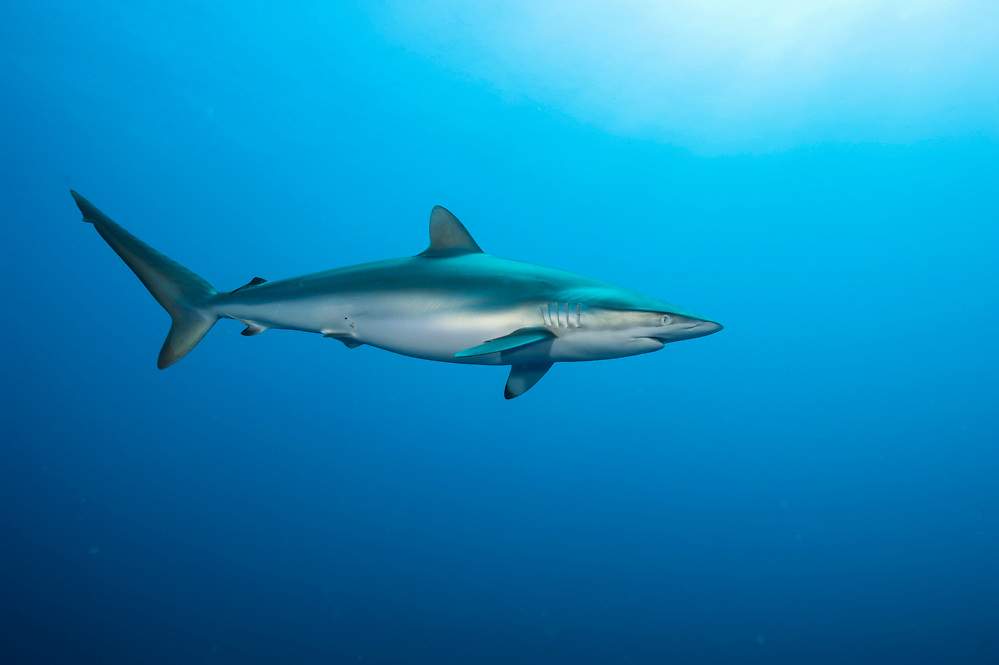
Species: Nurse, reef, whale (year-round), hammerhead (February-March), leopard, silky, thresher
Best time to Go: January-March
The Maldives is made up of 1.200 islands with 200 of them inhabitable. There are 26 atolls which are ring-shaped coral islands with lagoon centers. The diving here is high-quality and the reefs are in amazing condition. There is plenty of marine life and schools of fish everywhere you look.
Luckily enough the Maldives is also home to a total of 26 different species of sharks including whale, hammerhead, reef, silky, leopard, and nurse.
The waters are warm and stay around 82-86 F (28-30 C). Visibility is fantastic and ranges from 66-131 feet (20-40 m).
Huvadhoo is one of the atolls in the Maldives. It’s also the best place to see hundreds of reef sharks gathering to feed. Hundreds meaning at least 300 of them.
One of the most amazing aspects of diving in the Maldives is that there are whale sharks year-round. This is pretty rare and definitely something to take advantage of. However, the usual numbers of whale sharks drastically increase from January to March. This is when migrational feeding occurs in the region.
Silky sharks are one of the most common species in the area and are seen most commonly around the south of the atolls.
White and blacktip reef sharks are just about everywhere and you are pretty much guaranteed to see many on any one of your dives.
Tiger sharks usually hang out in really deep waters so sightings are rare but they do still occur.
The best time to see hammerheads in February through March at Fuvahmulah atoll.
Thresher sharks are also around Fuvamulah though they prefer to stay in deeper waters. You might get lucky and catch a glimpse of a few.
5.) Galapagos, Ecuador

Species: Galapagos, reef, hammerhead (December-May), dusky, silky, whale (June-November)
Best Time to Go: Year-round/ June-November for hammerheads
The Galapagos is a paradise for shark lovers of all kinds. The region is comprised of 19 islands and some spectacular dive sites. The Galapagos offers a vast array of shark species that are spotted at just about every dive site in the region.
Apart from sharks there are tons of fish like jacks, barracuda, turtles, dolphins, sea lions, marlin, frogfish, and stunning coral formations. You could dive for weeks on the islands and still not see it all.
The water temperatures vary depending on the time you go but range from 60-86 F (15-30 C). Visibility ranges from 40-100 feet (12-30 m).
By far the most common shark found in the Galapagos is the whitetip reef shark. Just about every dive site in the area will have a few whitetips roaming around. You have any easy 100% chance of seeing this shark on any dive you do on the islands.
Whitetip reef sharks are docile and not aggressive at all. However, it’s important to remember to maintain respect for this shark and never threaten of corner any shark of any kind.
Fast Fact: Whitetip reef sharks often sleep on top of each other.
Every year massive groups of scalloped hammerhead sharks migrate to the northern islands of the Galapagos. Both smooth and great hammerheads are found nearby but not in such high numbers as the scalloped species.
Hammerheads are here from December through May. The best places to go too see hammerheads are El Arco, Darwin Island and Roca Redonda, Isabella Island.
Dusky sharks look very similar to Galapagos sharks and are often misidentified because of it. Dusky sharks are generally found in large numbers around the central islands of the Galapagos.
Galapagos sharks are primarily in the waters around the northern islands of the Galapagos. Their average size is 10 feet (3 m) long and weighs an average of 100 pounds (45 kg). This species is considered aggressive and has been known to attack divers.
Galapagos sharks prefer to work in groups so if you have a close encounter you can be certain that the shark will return with reinforcement.
Whale sharks cruise on through the islands from June through November for some spectacular opportunities to swim with these gentle giants.
4.) Blue Corner and Siaes Corner, Palau

Species: Reef, leopard, whitetip, hammerhead,
Best time to Go: November-April
Palau is surrounded by lots of beautiful reefs and where this is reef there are reef sharks. Grey reef sharks are the most common species in the region as well as whitetip reef sharks.
Leopard sharks are much small than normal reef sharks and can be seen along reefs. Leopard sharks only grow to 5 feet (1.5 m) and weigh up to 22 pounds (10 kg).
Fishing for sharks is strictly prohibited in Palau as all sharks are protected under the shark sanctuary order. This prohibits commercial and recreational fishing for sharks and was the first of its kind introduced in 2009. Since then, many other places passed similar legislature including Maldives, Honduras, and the Bahamas.
The water temperatures are warm and range from 80-86 F (27-30 C). Visibility is impressive and goes all the way up to 200 feet (61 m).
The best time to dive in Palau is from November through April. Visibility is the best and so is the marine life.
In Blue Corner, boasts 13 different species of sharks like hammerheads, blacktip, whitetip, silvertip, blue, tiger, and grey.
The site includes a reef wall drop-off that ranges from 25-90 feet (8-27 m) deep. The currents here can be strong and unpredictable so it’s not the best place for true beginners.
It takes 60-70 minutes to reach Blue Corner by speedboat.
In Siaes Corner, expect tons and tons of grey reef sharks. Other marine life here include jacks, barracuda, turtles, tropical fish, and colorful coral reef.
It’s a less visited dive site which means there won’t be any crowds and the marine life will be abundant.
There is a 164 foot (50 m) drop-off at Siaes Corner and coral gardens in shallow waters nearby. The current can sometimes be strong at Siaes Corner so keep that in mind.
3.) Palencia, Belize
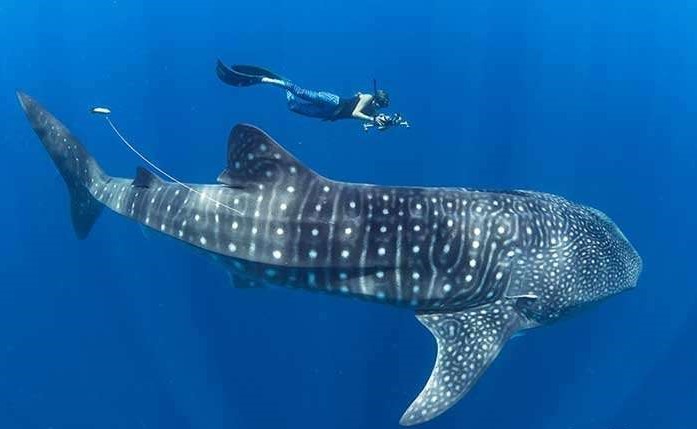
Species: Whale, reef, bull, hammerhead
Best Time to Go: March-June
One of the best places in the world to dive with whale sharks is in Palencia, Belize. Thirty miles (48 km) off the coast of Palencia is a reef called Gladden Spit. Over 20 species of fish come to lay their eggs here including the black snapper.
Whale sharks migrate to the reef specifically to feast on the eggs of black snapper. Whale sharks are actually known to migrate thousands of miles to visit feeding grounds.
Whale sharks can grow from 18-33 feet (5-10 m) and weigh up to 41,000 pounds (18,597 kg). They are slow swimmers (3 mph/ 5 kph) and very friendly. These sharks are filter feeders which means they don’t bite or chew.
Diving with whale sharks at Gladden Spit has been popular since the early 1990s.
The water temperature ranges from 77-86 F (25-30 C) and visibility maxes out at 98 feet (30 m). The depth ranges from 59-131 feet (18-40 m).
The best time to see the whale sharks is around the full moon. Two days before and up to 10 days after the full moon. April and May are the very best months.
Apart from whale sharks, there are lots of schools of tropical fish, rays, turtles, and dolphins.
The waters are deep and there is sometimes a current. For this it’s recommended that divers be more experienced and snorkelers have strong swimming skills.
2.) Tiger Beach, Bahamas
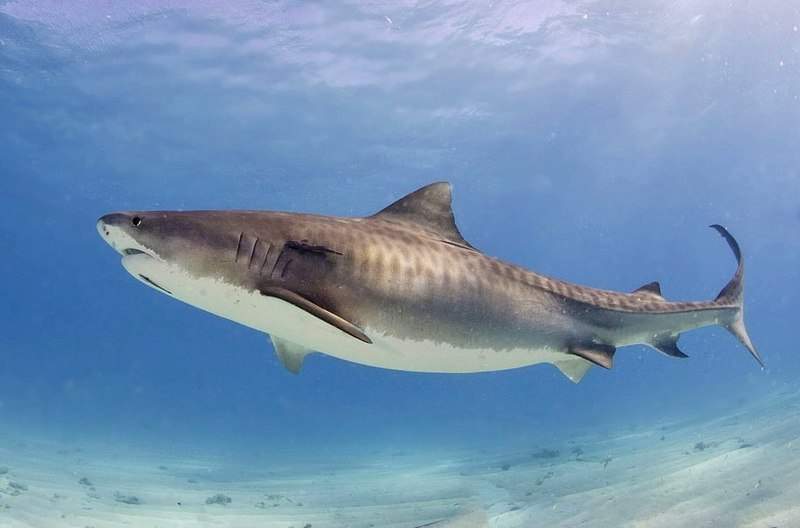
Species: Tiger, lemon, reef, nurse, bull, hammerhead (December-March)
Best Time to Go: October-January
Tiger beach got its name from the massive population of tiger sharks that reside off the shoreline. It’s actually one of the very best dive sites to freely swim with sharks.
There’s a 90% chance of seeing tiger sharks at Tiger beach. Many of the sharks are up to 18 feet (5 m) long.
Fishing for sharks in the Bahamas is illegal which has allowed many species to thrive in the area. So much so that it’s common to see 15-30 sharks at one time.
Water temperatures range from 72-83 F (22-28 C). Visibility is amazing (up to 400 feet/ 122 m) and the waters are shallow and very easy to dive. The majority of the dive will be around 20 feet (6 m) depth.
The sharks are usually fed chum to help them gather in one location for divers.
11 Unique Places to Dive in the Bahamas
Shark sightings occur year-round however the best encounters are from October through January. There are more sharks during these months. Hammerhead sharks are seen from December through March.
Liveaboard trips leave from West Palm Beach Florida or you can also book a trip while in the Bahamas.
1.) Malpelo Island, Columbia
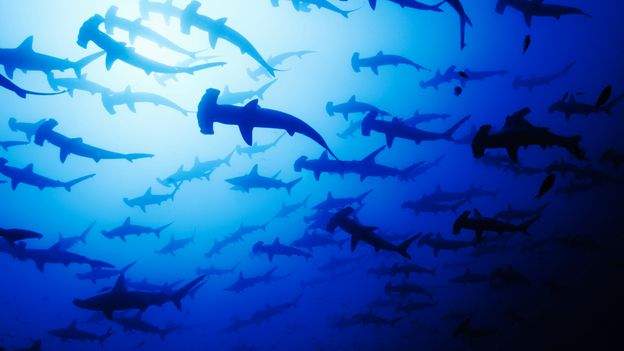
Species: Scalloped hammerhead, silky, whale, Galapagos, tiger
Best Time to Go: Year-round
Diving at Malpelo Island is so beyond amazing that it feels like a dreamt up fantasy. Populations of snapper, barracuda, and grunts are so dense they actually interrupt your overall visibility.
Malpelo Island in Columbia is literally know as the shark diving capital of the world so you know it had to be number one on the list.
Malpelo Island became a UNESCO World Heritage site in 2006 in recognition of its massive shark population.
The site La Nevara is the best place to see schools of over 200 scalloped hammerhead sharks. Silky sharks also frequent the area in similar numbers. It’s an amazing site and extremely exhilarating, to say the least.
What draws in such massive numbers of sharks are the cleaner fish. These cleaner fish actually eat bacteria from the sharks body, gills and mouth. It’s a symbiotic relationship where both parties involved benefit.
Whale sharks are most often seen on the north side of Malpelo Island.
At the dive site Bajo Del Monstruo, the rare smalltooth sand tiger sharks can sometimes be seen. These guys like to hang out in waters of at least 130 feet (39 m) deep. The smalltooth sand tiger shark grows up to 13.5 feet (4 m) and weighs up to 637 pounds (289 kg).
Water temperatures range from 62-82 F (16-28 C) depending on the time of year. Visibility is 33-100 feet (10-30 m).
The currents are strong and the seas are known to be rough. For these reasons, it’s not the best place for beginner divers. The only way to reach the location is on a liveaboard dive trip.
